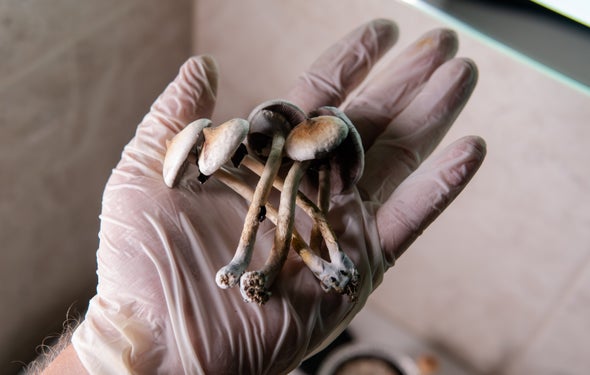Can Psychedelic Drugs Treat Physical Pain?

Scientific America – Updated for December 2021
Author: Troy Farah
When Kevin was just 11 months old, he was diagnosed with type 1 diabetes, which led to other health problems as he grew up: loss of vision in his left eye and peripheral neuropathy, a painful condition caused by nerve damage. Then, in 2019, a colonoscopy revealed he had colon cancer.
Feeling anxious and depressed, Kevin (a pseudonym) decided to try self-medicating with psychedelics, including psilocybin-containing “magic mushrooms.” Twice a week, the now 28-year-old delivery driver takes about half a gram of the outlawed fungi. This amounts to too little psilocybin to induce a full-blown trip, and Kevin says he quickly noticed an improvement in his mental health—a result that is in line with a handful of recent studies about the drug’s clinical potential. And he was pleasantly surprised to find that his physical pain seemed to decrease as well, even on the days he was not taking anything.
“A lot of the anxiety and depression I was dealing with started to fade away—and then the pain in my legs started to go away,” Kevin says. “I’m feeling the lasting effects from the psilocybin on my stomach and colon pretty much all the time.”
Vivid colors, warped textures and sounds, and intense introspection are famously associated with the psychedelic experience—and now, increasingly, so are improvements in mental health conditions such as anxiety and post-traumatic stress disorder. But what about pain relief? That is the question a growing number of researchers are asking, based on anecdotal reports that drugs such as LSD or psilocybin can help with this. Both drugs are currently illegal under federal law, though medical studies on them are now being officially cleared with increasing frequency.
From psychedelic start-ups to university labs, scientists are starting to test such drugs on various types of pain: cluster headaches, chronic pain, fibromyalgia and even phantom limb pain. This May a New York City–based, multimillion-dollar psychedelic start-up called Mind Medicine (MindMed) announced Project Angie—a series of studies using LSD and an undisclosed drug to treat chronic pain.
“We don’t really know how psychedelics work to modulate people’s long-term symptoms in any illness, let alone pain disorders, which are less studied than some of the others,” says physician Dan Karlin, MindMed’s chief medical officer. “But there is compelling preclinical evidence that they work … via psychological mechanisms … but also may have some direct effects on descending pain pathways.”
Tryp Therapeutics, a California-based psychedelic start-up, is exploring chronic pain relief using psilocybin and another, psilocybin-based drug with an undisclosed formulation that is obliquely called TRP-8803. The company has also partnered with the University of Michigan to study how these drugs might treat fibromyalgia, a complex and little understood condition blamed for pain throughout the body. Tryp has added leading psychedelic researcher Robin Carhart-Harris to its scientific advisory board, and the company says he will play a “critical role” in clinical trial design.
Earlier this year Yale University announced a trial using psilocybin for cluster headaches. And in August the Oxford, England–based pharmaceutical start-up Beckley Psytech raised $80 million for psychedelic research. Part of this will fund a phase 1b safety trial investigating low-dose psilocybin to treat a rare kind of headache called a short-lasting unilateral neuralgiform headache attack.
These efforts are in very early stages, and so far any results are far from clear. Some experts argue that the evidence for psychedelics relieving pain is weak and that these drugs are so powerful that they should only be used in psychotherapy—if anywhere. Even if psychedelics can relieve physical pain, they may not be better tools than those that are already widely available.
“Pain is this four-letter word that can mean so many different things,” says Vivianne Tawfik, an assistant professor of anesthesiology, perioperative and pain medicine at the Stanford University School of Medicine. At an outpatient clinic, Tawfik treats rare and refractory types of pain usually associated with surgery or injury, such as chronic neuropathic pain and complex regional pain syndrome. “There’s a role for opioids,” she says. “There might end up being a prescribed role for psychedelics. The jury’s still out.”
Tawfik warns that any off-target effects of psychedelics need to be carefully monitored. “I think abuse liability needs to be really closely considered, making sure that there aren’t unexpected psychiatric effects, certainly in populations at risk,” she says.
HISTORY OF PAIN AND PSYCHEDELICS
One of the earliest recorded studies of pain relief from psychedelics was conducted by Eric Kast, an Austrian-born physician who fled the Nazis with his family in 1938 and resettled in the U.S., later becoming an anesthesiologist at Chicago’s Cook County Hospital. Kast had an early interest in how to measure pain responses: in 1962 he designed an elaborate apparatus—a pneumatically operated “mechanical pain-producing device”—that used air pressure to let a subject apply a “pain-producing element” (possibly a needle) to their own leg.
Two years later his attention was drawn to the powerful psychedelic LSD, which he tried giving to 50 “gravely ill” patients afflicted by pain with causes ranging from cancer to gangrene. They first received the synthetic opioids hydromorphone (Dilaudid) and meperidine (Demerol)—and later they were given 100 micrograms of LSD as well. This would be a strongly psychoactive dose for most people.
“When compared with LSD-25, both [other] drugs fell short in their analgesic action,” Kast wrote in 1964. It was a remarkable anecdote but barely investigated further. For decades this remained some of the best research in this area, aside from a few case studies.
“I feel like most of the studies that were done weren’t done well,” says Fadel Zeidan, a neuroscientist who studies the underlying mechanisms of pain and mindfulness at the University of California, San Diego. Zeidan, who is co-leading a study on psilocybin for phantom limb pain, would like to see “higher standards, more rigor” in this area of research. In 2020 he co-authored a review that weighed the evidence of psychedelics relieving chronic pain and proposed a mechanism of action. The review noted that psychedelics act on the body’s serotonin receptors—notably the type known as 5-HT2A—which have been linked in some research to the development of chronic pain.
“Serotonin is also involved in descending modulation of pain [from the brain] down to the spinal cord,” Tawfik says. But she and others note there are currently very little data to back up the hypothesis that psychedelic pain relief acts through this mechanism. “Even though we know that some of the receptor systems that underlie pain are probably similar, there’s probably a lot of nuance that we don’t really know yet or appreciate.”
One of the few double-blind, randomized, placebo-controlled studies on this topic was published last year. Researchers at the Netherlands’ Maastricht University and their colleagues trialed 24 people who were given an oral solution of ethanol containing either a low dose of LSD (too low to cause strong effects such as visual disruptions) or a placebo. Then the subjects placed their hands in almost freezing water. The longer they could keep their hands submerged, the better their pain tolerance was determined to be.
Ratings of pain tolerance from subjects who received LSD were comparable to those in studies with the opioids oxycodone and morphine, leading the authors to conclude in the Journal of Psychopharmacology that “low doses of LSD might constitute a novel pharmacological therapy.”
Again, the researchers hypothesized that serotonin receptors had a role in this effect. Two of the scientists who conducted this study, Matthias Liechti of the University of Basel and Kim Kuypers of Maastricht University, are currently working with MindMed on its LSD and pain research. And the paper’s lead author, Johannes Ramaekers of Maastricht University, says he is developing another pain study to look at psychedelics and fibromyalgia.
But Boris Heifets, a Stanford Medicine anesthesiologist who studies pain—as well as “rapid acting psychiatric therapies,” including psychedelics—says the focus on serotonin in pain relief is probably a “red herring.” Heifets (who is beginning a trial looking at psilocybin and chronic lower back pain) argues that the fact that psychedelics can also improve mood should not be overlooked, given neurological connections between pain and depression.
“If these drugs are going to help, it’s going to be much like the way we think they help for depression—[that is], changing your relationship to your pain,” Heifets says, emphasizing that psychotherapy is the core of psychedelics’ apparent effectiveness in mental health. “The revolution with this class of medicines is that it’s really not just medication alone…. This whole body of research is emphasizing the importance of therapy, psychological support and connection.”
U.C. San Diego’s Zeidan agrees. What a drug like psilocybin could be doing is helping “treat the whole person,” he says—adding that he believes this should be a greater focus of modern medicine in general.
“Chronic pain is really just this comorbid snowball of shit,” Zeidan says. “It’s not only the sensory abnormalities, but it’s also the depression, the anxiety, the sedentary lifestyle, the self-doubt, learned helplessness—it’s this whole thing.”
Again, the researchers hypothesized that serotonin receptors had a role in this effect. Two of the scientists who conducted this study, Matthias Liechti of the University of Basel and Kim Kuypers of Maastricht University, are currently working with MindMed on its LSD and pain research. And the paper’s lead author, Johannes Ramaekers of Maastricht University, says he is developing another pain study to look at psychedelics and fibromyalgia.
But Boris Heifets, a Stanford Medicine anesthesiologist who studies pain—as well as “rapid acting psychiatric therapies,” including psychedelics—says the focus on serotonin in pain relief is probably a “red herring.” Heifets (who is beginning a trial looking at psilocybin and chronic lower back pain) argues that the fact that psychedelics can also improve mood should not be overlooked, given neurological connections between pain and depression.
“If these drugs are going to help, it’s going to be much like the way we think they help for depression—[that is], changing your relationship to your pain,” Heifets says, emphasizing that psychotherapy is the core of psychedelics’ apparent effectiveness in mental health. “The revolution with this class of medicines is that it’s really not just medication alone…. This whole body of research is emphasizing the importance of therapy, psychological support and connection.”
U.C. San Diego’s Zeidan agrees. What a drug like psilocybin could be doing is helping “treat the whole person,” he says—adding that he believes this should be a greater focus of modern medicine in general.
“Chronic pain is really just this comorbid snowball of shit,” Zeidan says. “It’s not only the sensory abnormalities, but it’s also the depression, the anxiety, the sedentary lifestyle, the self-doubt, learned helplessness—it’s this whole thing.”





